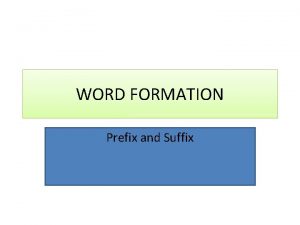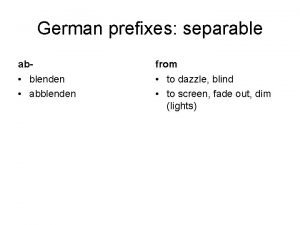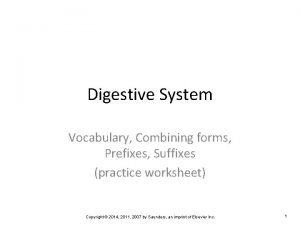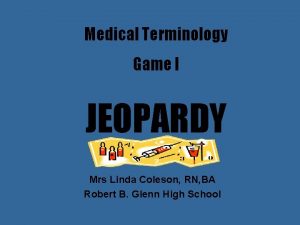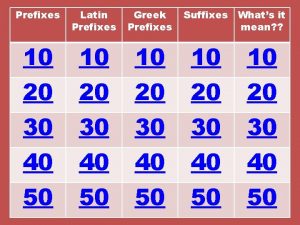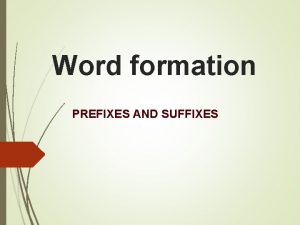PREFIXES SUFFIXES DERIVE ADJECTIVE USE ARIS E OR











- Slides: 11

PREFIXES + SUFFIXES

DERIVE ADJECTIVE USE –ARIS, E OR –ALIS, E ACROMION PATELLA OS (mouth) TIBIA OCCIPUT FIBULA DIGITUS PALMA MAXILLA CAPUT STERNUM SCAPULA DENS CLAVICULA CAPUT TRACHEA INTESTINUM DUODENUM CELLULA MANUS FEMUR DORSUM

EXPLAIN THE MEANING OF WORDS DERIVES BY PREFIXES AND SUFFIXES digitatus digitatio DIGITUS stimulus digitalis stimulator STIMULARE stimulans digitiformis stimulatio deformans formula retromammaris mammalia MAMMA mamillaris FORMA deformitas deformatio mamilla capitatus capitulum caput decapitatio occipitalis

IDENTIFY THE SUFFIX, EXPLAIN ITS MEANING strictura caudatus circulatio aciditas lacteus hepaticus foramen lobulus ligamentum latitudo adductor obesitas cerebellum tuberculum arteriola ventralis

FORM FIVE TERMS BY COMBINING THE FOLLOWING PREFIXES/ROOTS/SUFFIXES: IM- -CAPIT- NAT- -IA DYS- -CELL- -MOBIL- -AL- -ITAS INTRA- -ALIS -PEPS- -ARIS -ITAS -UL- SUB-

1: LABEL FOLLOWING STRUCTURES/ORGANS IN LATIN 2: DERIVE ADJECTIVES USING THE FOLLOWING ENDINGS: a) -eus, a, um (3 x) b) -aris, e (1 x) Pulmonalis, e Ventricularis, e c) -icus, a, um (2 x) Palpebra Ventriculus Palpebralis, e Cutaneus, a, um Hepaticus, a, um Osseus, a, um Renalis, e Pancreaticus, a, um Intestinalis, e d) -alis, e (5 x) Intestine Artery Arterialis, e Tendon Tendineus, a, um

TO DESIGNATE DIFFERENT MUSCLES USE PREFIXES AND SUFFIXES: SUB- AB- -ILIS -OR -ATUS -OIDEUS It is a flat, quadrilateral skeletal muscle located on the posterior side of the hip joint, besides other functions it also acts to stabilize the femoral head in the acetabulum, it is called musculus __________ In English this muscle is called slender muscle of the thigh, what should be its name in Latin? Musculus __________ A long, heavy triangular muscle of the medial aspect of the thigh which acts to pull a thigh away from the body is: musculus __________ magnus A large triangular muscle that covers the shoulder joint and serves to abduct, flex, extend and rotate the arm is: musculus __________ This muscle is of triangular shape and it is placed under the collar bone, it is: musculus __________

NAME ANATOMICAL STRUCTURES ON THE BASE OF DEFINITIONS AND/OR IMAGES: The angle between the right and left costal arch which is measured under the sternum is called angulus ___________ Small branches of aorta thoracica that supply the posterior wall of the pericardium are named rami___________ Rough bony area between external lip of the iliac crest (labium externum ossis ilii) and internal lip of the iliac crest (labium internum ossis ilii) is labeled as linea ___________ The Latin name for ligaments which are lying outside a joint capsule is ligamenta___________ Delicate displaceable connective tissue which lies on the top of the fascial sheath of the eye bulb (fascia bulbi oculi) should be called lamina ___________ Authonomic nerve plexus around the subclavian artery is labeled as plexus ___________

Atelectasis pulmonum Ø a collapsed or airless state of the lung, which may be acute or chronic, and may involve all or part of the lung. The primary cause is obstruction of the bronchus serving the affected area.

maceratio 1. Softening by the action of a liquid. 2. Softening of tissues after death by nonputrefactive (sterile) autolysis; seen especially in the stillborn, with detachment of the epidermis.

asphyxia A condition in which an extreme decrease in the concentration of oxygen in the body accompanied by an increase in the concentration of carbon dioxide leads to loss of consciousness or death. Asphyxia can be induced by choking, drowning, electric shock, injury, or the inhalation of toxic gases. Ø a- +greek. sfyxis or sfygmos =pulse


